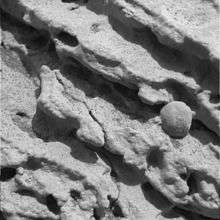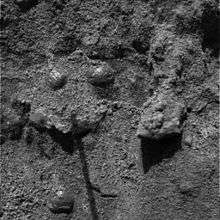Martian spherules
Martian spherules (also known as blueberries due to their blue hue in false-color images released by NASA) are the abundant spherical hematite inclusions discovered by the Mars rover Opportunity at Meridiani Planum on the planet Mars.[1]

Initial discovery
The Mars Global Surveyor Thermal Emission Spectrometer (TES) first detected “crystalline hematite (α‐Fe2O3)” within Sinus Meridiani from orbit.[2] The presence of hematite was confirmed after the Opportunity rover landed in Meridiani Planum.[1] The moniker "blueberries" was coined by the original science team due to the hematite appearing blue relative to the surrounding media in the "natural color RGB images" analyzed.[3]
Causes
"A number of straightforward geological processes can yield round shapes," says Hap McSween.[4] These include accretion under water, meteor impacts, or volcanic eruptions.[4] The principal investigator, Steve Squyres, indicates they could alternately be concretions, or accumulated material, formed by minerals coming out of solution as water diffused through rock.[5]


Blueberries Size
Researchers at NASA’s Jet Propulsion Laboratory studied all the soil environments observed by Opportunity, and therefore studied the blueberries from Eagle Crater to Endurance (crater). They found that in a sample of 696 blueberries, disregarding any non-spherical blueberries from the sample, the blueberries average major axis to be about 2.87 mm (just over 1/10th inch). They also discovered blueberries that are found within soils are typically smaller than blueberries found in the outcrops. They noted the size of the blueberries tends to decrease with decreasing latitude. [6]
The JPL team found many fragmented blueberries and suggested the fracturing occurred after spherule formation. They believe the fracturing either be from meteoric impacts, or the “same process” that “fractured the outcrop.” However, the team note this would not explain the presence of the smallest hematite spherules detected. The smallest are close to perfectly spherical and therefore cannot be explained by fracturing or erosion.[6]
NASA’s JPL also found that blueberries uncovered by the Rock Abrasion Tool aboard Opportunity were about 4 mm (0.16 inches) semi-major axis length at Eagle Crater and Endurance crater, about 2.2mm (0.087 inches) at Vostok, and about 3.0 mm (0.12 inches) at Naturaliste (crater). Those found in “the plains” were smaller (1-2mm or 0.04-0.08 inches) than those of Eagle and Endurance craters.[6]
Earth analogs
Researchers from the University of Utah have explored the similarities between the blueberries and spherical concretions discovered within “Jurassic Navajo Sandstone” in southern Utah. They have concluded Mars must have had previous ground water activity to form the blueberries. However, they do note the spherules are more spherical in the Martian sample due to the lack of “joints, fractures, faults, or other preferential fluid paths,” unlike the Utah sample.[7] A team of researchers from Japan studied the spherules found in Utah as well as spherules that were later discovered in Mongolia, in the Gobi. They found evidence that the concretions found in these locations are first formed as “spherical calcite concretions” in sandstone. Acidic water rich in iron then dissolve the calcite leaving behind the iron rich (hematite) spherule. This leads to the conclusion that the blueberries may have formed early in Mars’s history when the atmosphere was more dense by the same process.[8]
See also
- Moqui Marbles
- List of surface features of Mars imaged by Opportunity
References
- Dvorsky, George (15 February 2019). "The Enduring Mystery of the Martian 'Blueberries' Discovered by Opportunity Rover". Gizmodo. Retrieved 15 February 2019.
- Christensen, P. R.; Bandfield, J. L.; Clark, R. N.; Edgett, K. S.; Hamilton, V. E.; Hoefen, T.; Kieffer, H. H.; Kuzmin, R. O.; Lane, M. D.; Malin, M. C.; Morris, R. V.; Pearl, J. C.; Pearson, R.; Roush, T. L.; Ruff, S. W.; Smith, M. D. (2000). "Detection of crystalline hematite mineralization on Mars by the Thermal Emission Spectrometer: Evidence for near-surface water". Journal of Geophysical Research: Planets. 105 (E4): 9623–9642. Bibcode:2000JGR...105.9623C. doi:10.1029/1999JE001093. ISSN 2156-2202.
- Calvin, W. M.; Shoffner, J. D.; Johnson, J. R.; Knoll, A. H.; Pocock, J. M.; Squyres, S. W.; Weitz, C. M.; Arvidson, R. E.; Bell, J. F.; Christensen, P. R.; Souza, P. A. de; Farrand, W. H.; Glotch, T. D.; Herkenhoff, K. E.; Jolliff, B. L.; Knudson, A. T.; McLennan, S. M.; Rogers, A. D.; Thompson, S. D. (2008). "Hematite spherules at Meridiani: Results from MI, Mini-TES, and Pancam". Journal of Geophysical Research: Planets. 113 (E12): E12S37. Bibcode:2008JGRE..11312S37C. doi:10.1029/2007JE003048. ISSN 2156-2202.
- "Mars Exploration Rover Mission: Press Releases". NASA. Retrieved 23 January 2017.
- "Dining on Diamonds - Astrobiology Magazine". Astrobiology Magazine. 2004-08-05. Retrieved 23 January 2017.
- Weitz, C. M.; Anderson, R. C.; Bell, J. F.; Farrand, W. H.; Herkenhoff, K. E.; Johnson, J. R.; Jolliff, B. L.; Morris, R. V.; Squyres, S. W.; Sullivan, R. J. (2006). "Soil grain analyses at Meridiani Planum, Mars". Journal of Geophysical Research: Planets. 111 (E12): n/a. Bibcode:2006JGRE..11112S04W. doi:10.1029/2005JE002541. ISSN 2156-2202.
- Chan, Marjorie A.; Beitler, Brenda; Parry, W. T.; Ormö, Jens; Komatsu, Goro (17 June 2004). "A possible terrestrial analogue for haematite concretions on Mars". Nature. 429 (6993): 731–4. Bibcode:2004Natur.429..731C. doi:10.1038/nature02600. PMID 15201902.
- Yoshida, H.; Hasegawa, H.; Katsuta, N.; Maruyama, I.; Sirono, S.; Minami, M.; Asahara, Y.; Nishimoto, S.; Yamaguchi, Y.; Ichinnorov, N.; Metcalfe, R. (1 December 2018). "Fe-oxide concretions formed by interacting carbonate and acidic waters on Earth and Mars". Science Advances. 4 (12): eaau0872. Bibcode:2018SciA....4..872Y. doi:10.1126/sciadv.aau0872. ISSN 2375-2548. PMC 6281427. PMID 30525103.
External links
- Science Magazine special issue on MER Opportunity initial results
- Press releases from JPL relating to Mars spherules: Initial press release, composition results
- Morphological Investigations of Martian Spherules, Comparisons to Collected Terrestrial Counterparts. Full text PDF.
- Sedimentary Concretions vs. Impact Condensates: Origin of the Hematitic Spherules of Meridiani Planum, Mars. Full text PDF.
- Ironstone Concretions - Analogs to Martian Hematite Spherules. Full text PDF.
- Moqui Marbles relations to Martian Spherules.
- ScienceDaily.com on Moqui marbles and Martian spherules
- relations to cyanobacteria and terrestrial stromatolites.